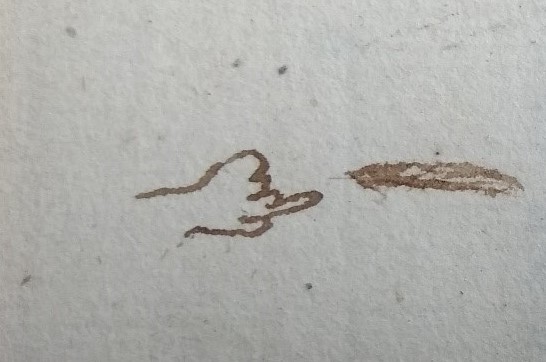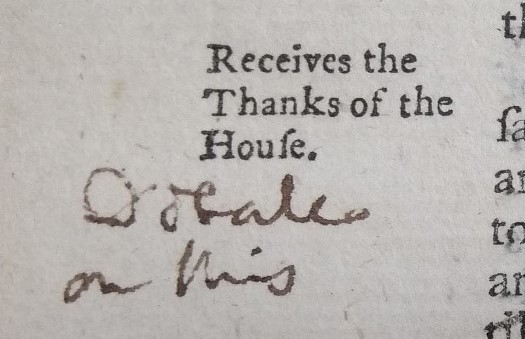Welcome to the third in a new series of blogs that will hopefully be appearing throughout the year to interest, intrigue and, one hopes, entertain followers of the goings-on of Innerpeffray Library. The theme is a general one, but should deliver up something to pique everyone’s interest at some point. For those of you lucky enough to have visited the Library, you will have noticed that the shelves really do go from floor to ceiling and, as a result, there are some shelves that really do not get the attention that they perhaps deserve. This series aims to remedy this injustice by dragging out the ladder and going for a quick Tour of the Tops to see what gems there are awaiting true recognition! This ‘Episode’ takes a look at some vaguely topical references, as well as taking a look at Sweden’s most famous King!
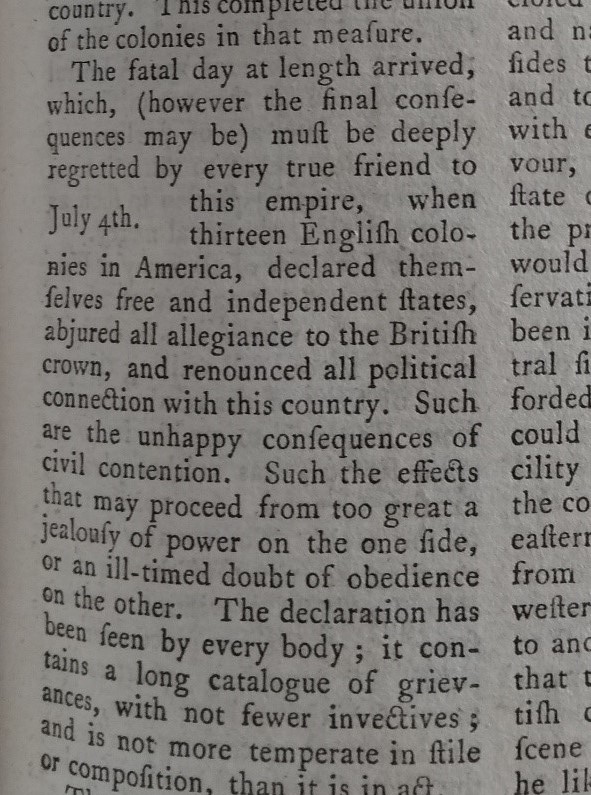
I moved into a new cabinet for today’s tour and this one was filled with a lot of books with very similar titles. The first set were all called the “Annual Register” for different years and these proved to be jolly interesting. I happened to be looking on 4th July and, as such, I sought out the 1776 edition to see if it had any juicy commentary on the Declaration of Independence. I was not disappointed… The section on “History of Europe” had a superb section describing the occasion as “deeply regretted by every true friend to this empire”. The declaration itself is “not more temperate in stile or composition, than it is in act”. Scathing criticism of the Declaration there! It is not perhaps as strong as the text found within the Scots Magazine for the same year, as that contains the full text of the Declaration with substantial amounts of editorial critique, whereas the text is just presented here without comment. The “Annual Register” does, however, have a number of other really fascinating sections. Not only does it have an account of major events during the year, but it also has significant births, deaths and marriages as well as a plethora of papers on different subjects and even some poetry! If you want to capture the feel of the book, it felt like it fitted the tagline “if you only buy one newspaper this year, make sure it’s the ‘Annual Register’!”.

I could quite easily spend the rest of this “episode” on just the book (and to think, this is just one year of many that we have at the Library!), so I shall just throw in a few choice sections from this one. Firstly, we have an account of a meeting between a British noblewoman and a man referred to as “Il Re”… The exiled Bonnie Prince Charlie! A lot of the text is taken up with whether she should reply to him or not – apparently the Pope had ordered that no English stranger should speak with him! – but, as can be seen from the section in the photo, it seems that natural curiosity won the day in the end! Her description does the elderly Prince no favours: “He appears bloated and red in the face, his countenance heavy and sleepy, which is attributed to his having given into excess of drinking”. It seems that this account would do little to inspire any Jacobites eager to hear of the man they believed was the rightful King!
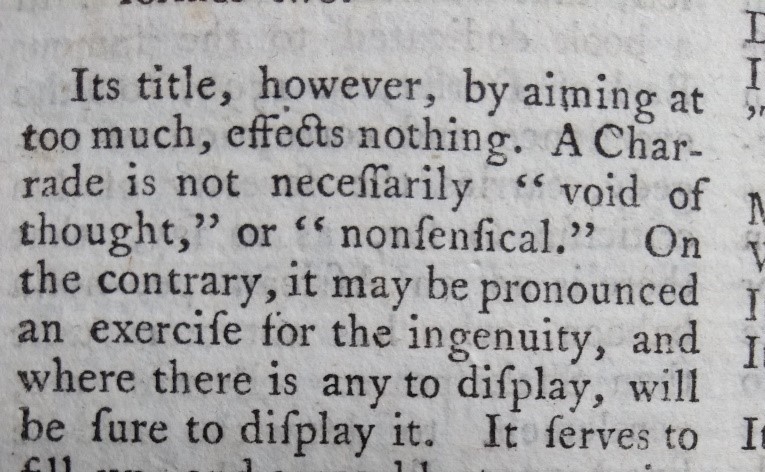
The final section I want to share is on Charades, but not quite as we know them now… Instead of being a silent game to guess a book, film, TV show etc., it appears to be a formalised form of riddles with compound nouns. The author clearly feels the need to defend them against those who are unimpressed by them as can be seen in the photo! A reference is made to David Garrick, actor and playwright, playing the game too, so it must be acceptable. I leave this remarkable book with one of the Charades (answer at the end of the “Episode”!):
“My first is one of England’s prime boasts; it rejoices the ear of a horse, and anguishes the toe of a man. My second, when brick, is good, when stone better, when wooden, best of all. My whole is famous alike for rottenness and tin.” Good luck!

My second book was also part of a large series on the upper shelves, this time concerning the proceedings of the Houses of Commons and Lords. I was originally looking for further Independence Day material, but got distracted by the first volume and delving into the correspondence between Parliament and the newly restored King Charles II in 1660. This was a fascinating time, as the kingdom effectively underwent a coup d’état that called for the restoration of the Stuart monarchy after the Commonwealth fell apart. This, of course, entailed quite the about turn for the House of Commons given it had been responsible for executing the new King’s father… I should, of course, note that by the time these proceedings began, the “Long” Parliament had been dissolved and a new body elected, so this was not the same group of men who had been in power during the Civil War and was quite clearly very Royalist in outlook. Having said that, it seems that the tone chosen was obsequious in nature, perhaps too extremely so! Charles I is described as the new King’s “most Royal Father of glorious Memory” – not a description one would recognise of him in today’s history books! The critical passage, though, is that in the extract below:
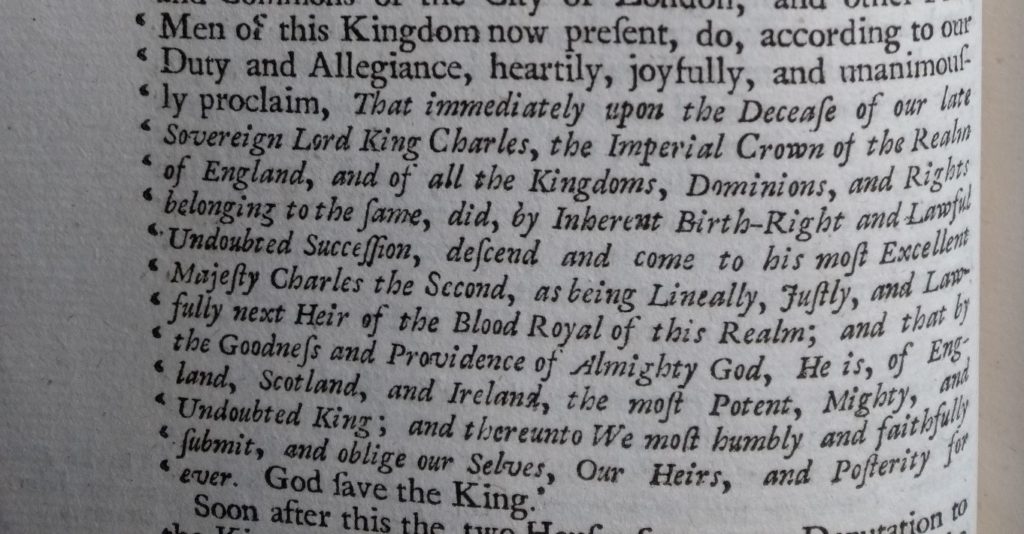
This was the crucial text that effectively decreed that the past eleven years had not happened and that there had been no Commonwealth, Cromwell had never become Lord Protector and that King Charles II had become King the moment his “most Royal Father” had died. It also opened the door wide open for prosecution of those who had acted against the new (oops, sorry, of course, he’s not new anymore!) King during the previous eleven years, as they were acting against the man whom God has declared to be the Undoubted King! Powerful stuff, and with a huge impact on British history, restoring, as it did, the line of monarchs that continues to this day.
As with the Annual Register, I feel that there will be a lot of fascinating information across the other books in this series, but again I just focussed on this one! I had a meander through the rest of the text and was intrigued by a number of marginalia and even a manicule! Interestingly, some of the marginalia appeared to have been cut off and, on consultation with the Keeper of the Books, this indicates that they were written before the book was rebound, which can give some indication of the date of the notes as most of the Library’s books were rebound in the 19th Century. I wonder who made notes and to what purpose? The text “Debate on this” appears a number of times. Is it a note about the debate described in the text, or could it be perhaps a note from a schoolmaster to a pupil, or a reminder to himself that this would be a good thing for a class to discuss? My guess is as good as yours! It really is amazing what you can find in books at Innerpeffray!
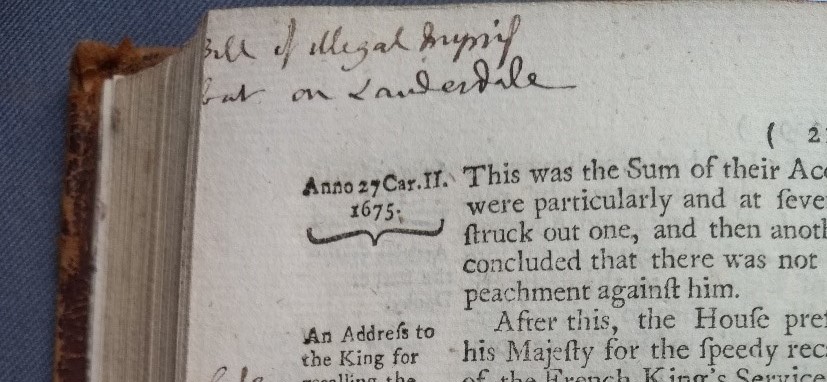
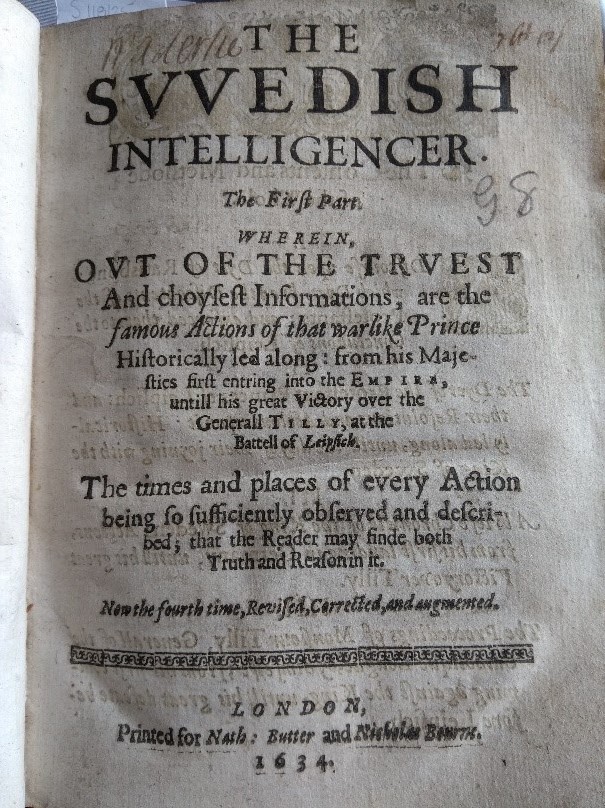
Our final book today is, unlike the other two, a one-off! It’s not part of a big series, but it was quite a sizeable book nonetheless! It is also one of the 400 or so books that has been in the Library since its inception, as the frontispiece shows with the signature of Madertie at the top left next to the title “The Swedish Intelligencer” – an account of the life of Gustavus Adolphus, King of Sweden and Lion of the North! I have to admit, this is another book that I was expecting to find as it’s one of the Keeper’s favourite books! Gustavus Adolphus was perhaps Sweden’s most famous monarch and led Protestant armies to victories as part of the Thirty Years War, so this account of his life would have made for extremely popular reading in Protestant Britain of the 1630s. It was published within two years of his death at the Battle of Lützen so very much capitalising on his stellar reputation. The book has a very detailed account of his life, but with a clear focus on the battles and, as a result, there are some really lovely maps and battle plans within the book. However, it seems that some of them must have been rushed somewhat… Look at the map below

Seems like a perfectly normal plan of a battle, yes? With a title at the top? Hmm, well, a closer look at the text shows that this is not actually a title…

Apologies for the not great photo quality, but I feel it has to be seen to be believed! “Our Cutter hath made the Ordnance too long, to lye too farre into the River. The Hole also marked R, should have beene on the right hand of Bridge.” Yes, that’s right, there is a note from the printer saying the image has a number of errors! Unbelievable! It just goes to show the difficulty that they would have trying to redo the woodcut – it was clearly a ‘better’ option to put the explanation in at the top when printing it. Can you imagine a modern day book doing likewise..?!
And with that fascinating insight into the mind of a 17th Century printer, we come to the end of this third ‘episode’ of the Tour of the Tops. I trust that you have enjoyed the latest selection from the uppermost shelves of Innerpeffray! Unlike last time, I am pleased to say that I have another three books ready to share with you, so join me soon for the fourth instalment where we read about ‘orrible deaths and mysterious going-ons throughout English history, discover the somewhat wilder side of our most famous playwright and have a wander through the stars with a slightly pedantic writer of marginalia! All of this will be coming soon to the Innerpeffray blog, so keep an eye out and stay safe.
The answer to the riddle is Corn-wall (with apologies to any current residents – I am sure it is no longer famous for its rottenness! It has been suggested that this is a reference to “rotten boroughs” – constituencies that had a very small number of voters, often under the control of a single person, for historical reasons. Apparently, Cornwall was home to a number of them! Alternative explanations welcomed!).

